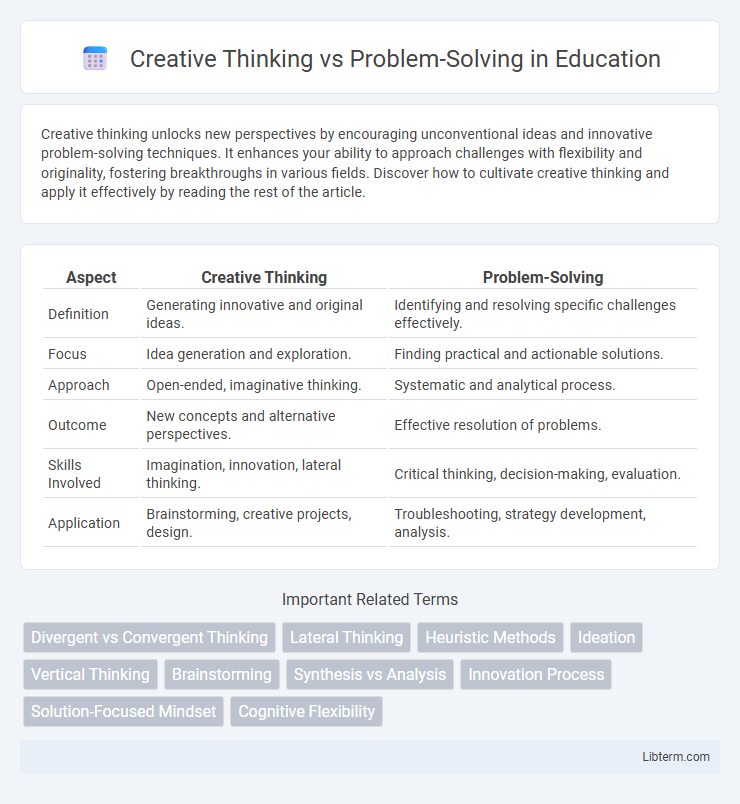Creative thinking unlocks new perspectives by encouraging unconventional ideas and innovative problem-solving techniques. It enhances your ability to approach challenges with flexibility and originality, fostering breakthroughs in various fields. Discover how to cultivate creative thinking and apply it effectively by reading the rest of the article.
Table of Comparison
| Aspect | Creative Thinking | Problem-Solving |
|---|---|---|
| Definition | Generating innovative and original ideas. | Identifying and resolving specific challenges effectively. |
| Focus | Idea generation and exploration. | Finding practical and actionable solutions. |
| Approach | Open-ended, imaginative thinking. | Systematic and analytical process. |
| Outcome | New concepts and alternative perspectives. | Effective resolution of problems. |
| Skills Involved | Imagination, innovation, lateral thinking. | Critical thinking, decision-making, evaluation. |
| Application | Brainstorming, creative projects, design. | Troubleshooting, strategy development, analysis. |
Introduction to Creative Thinking and Problem-Solving
Creative thinking involves generating innovative ideas and exploring multiple perspectives to approach challenges, enhancing cognitive flexibility and originality. Problem-solving focuses on identifying, analyzing, and implementing effective solutions to specific obstacles through logical and structured methods. Both skills are essential for adapting to complex situations, driving innovation, and achieving successful outcomes in personal and professional contexts.
Defining Creative Thinking
Creative thinking involves generating original ideas and novel approaches by exploring beyond traditional boundaries and combining concepts in innovative ways. It emphasizes divergent thinking, imagination, and the ability to envision multiple possibilities to address challenges or opportunities. This cognitive process drives innovation by encouraging experimentation and risk-taking without immediate concern for practical constraints.
Understanding Problem-Solving
Problem-solving involves systematically identifying, analyzing, and resolving obstacles by applying logical and critical thinking skills to generate effective solutions. It often requires breaking down complex issues into manageable parts to evaluate potential outcomes and select the most viable strategy. Mastery of problem-solving enhances decision-making efficiency and drives successful project completion across various fields.
Key Differences Between Creative Thinking and Problem-Solving
Creative thinking involves generating original ideas and exploring possibilities without immediate constraints, emphasizing innovation and divergent thought processes. Problem-solving focuses on identifying specific issues, analyzing relevant data, and applying logical strategies to arrive at practical and effective solutions. The key difference lies in creative thinking's open-ended exploration versus problem-solving's goal-oriented approach to resolving defined challenges.
The Role of Creativity in Problem-Solving
Creative thinking fuels innovative problem-solving by enabling individuals to generate unique ideas and approaches beyond conventional methods. It enhances cognitive flexibility, allowing the exploration of diverse perspectives and the discovery of novel solutions to complex challenges. Integrating creativity in problem-solving processes leads to more effective and sustainable outcomes across various fields such as business, technology, and education.
Techniques to Enhance Creative Thinking
Techniques to enhance creative thinking include brainstorming, mind mapping, and lateral thinking exercises that encourage divergent thought processes. Utilizing diverse perspectives and challenging assumptions fosters innovative solutions beyond conventional problem-solving methods. Incorporating techniques such as SCAMPER (Substitute, Combine, Adapt, Modify, Put to another use, Eliminate, Reverse) amplifies idea generation and nurtures originality in creative thinking.
Strategies for Effective Problem-Solving
Effective problem-solving strategies include clearly defining the problem, generating multiple creative solutions, and evaluating options based on feasibility and impact. Utilizing techniques such as brainstorming, mind mapping, and root cause analysis enhances the ability to approach problems from diverse perspectives. Implementing iterative testing and feedback loops ensures solutions are refined and aligned with desired outcomes.
Benefits of Integrating Both Skills
Integrating creative thinking with problem-solving enhances innovation by generating diverse solutions and enabling adaptive strategies. This combination improves decision-making efficiency and fosters resilience in complex environments. Organizations leveraging both skills experience increased productivity and competitive advantage through continuous improvement.
Real-World Applications and Examples
Creative thinking drives innovation by generating unique ideas, as seen in product design where novel concepts like Tesla's electric cars revolutionized transportation. Problem-solving applies analytical skills to address specific challenges, exemplified by NASA engineers overcoming technical hurdles to successfully land rovers on Mars. Businesses integrate both by using creative brainstorming to devise strategies and problem-solving techniques to implement effective solutions in real-world scenarios.
Conclusion: Balancing Creativity and Solutions
Balancing creativity and problem-solving involves integrating innovative ideas with practical execution to achieve effective results. Creative thinking fuels the generation of unique solutions, while problem-solving ensures those ideas are feasible and actionable. Organizations that cultivate both skills enhance adaptability and drive sustained success in complex challenges.
Creative Thinking Infographic

 libterm.com
libterm.com